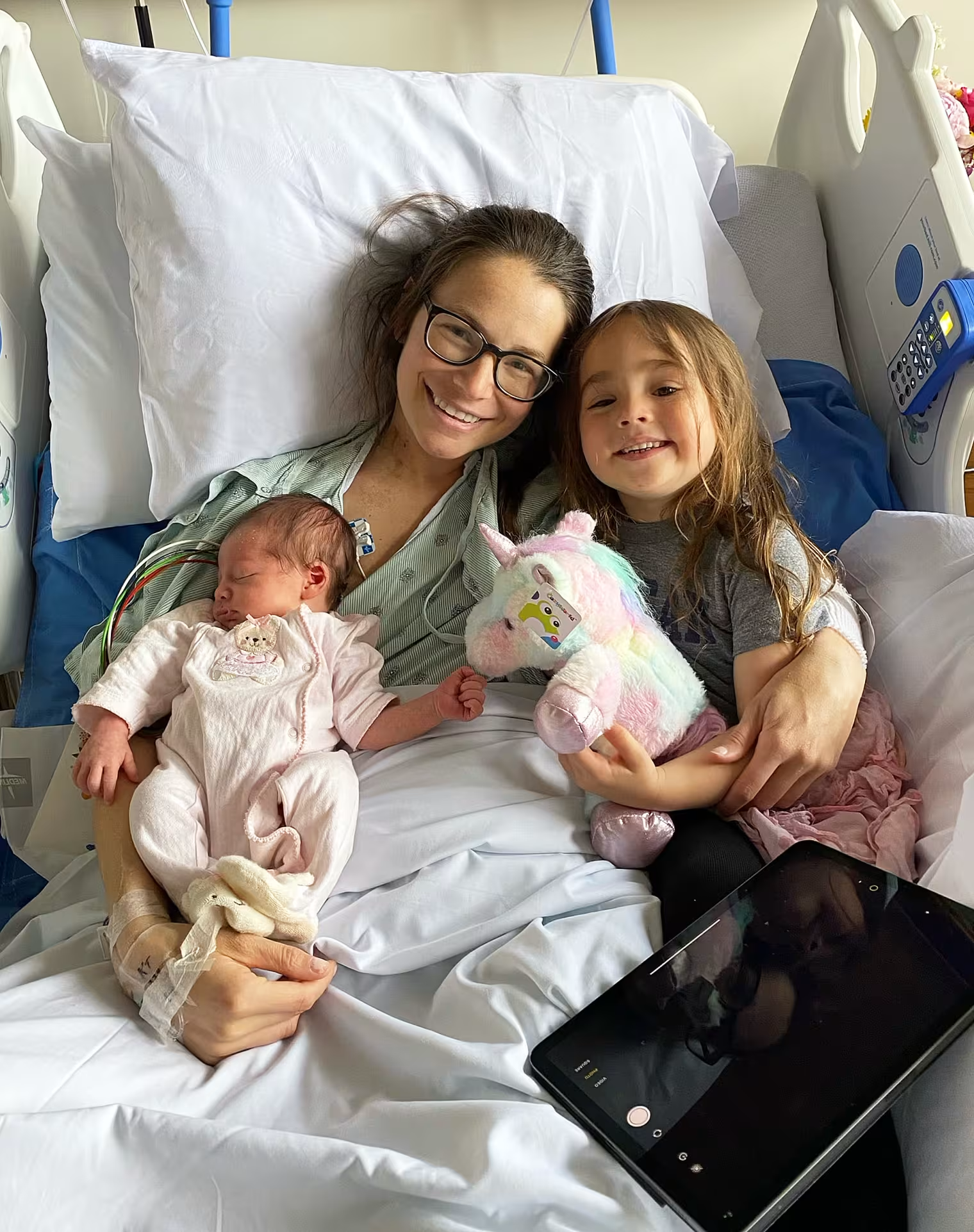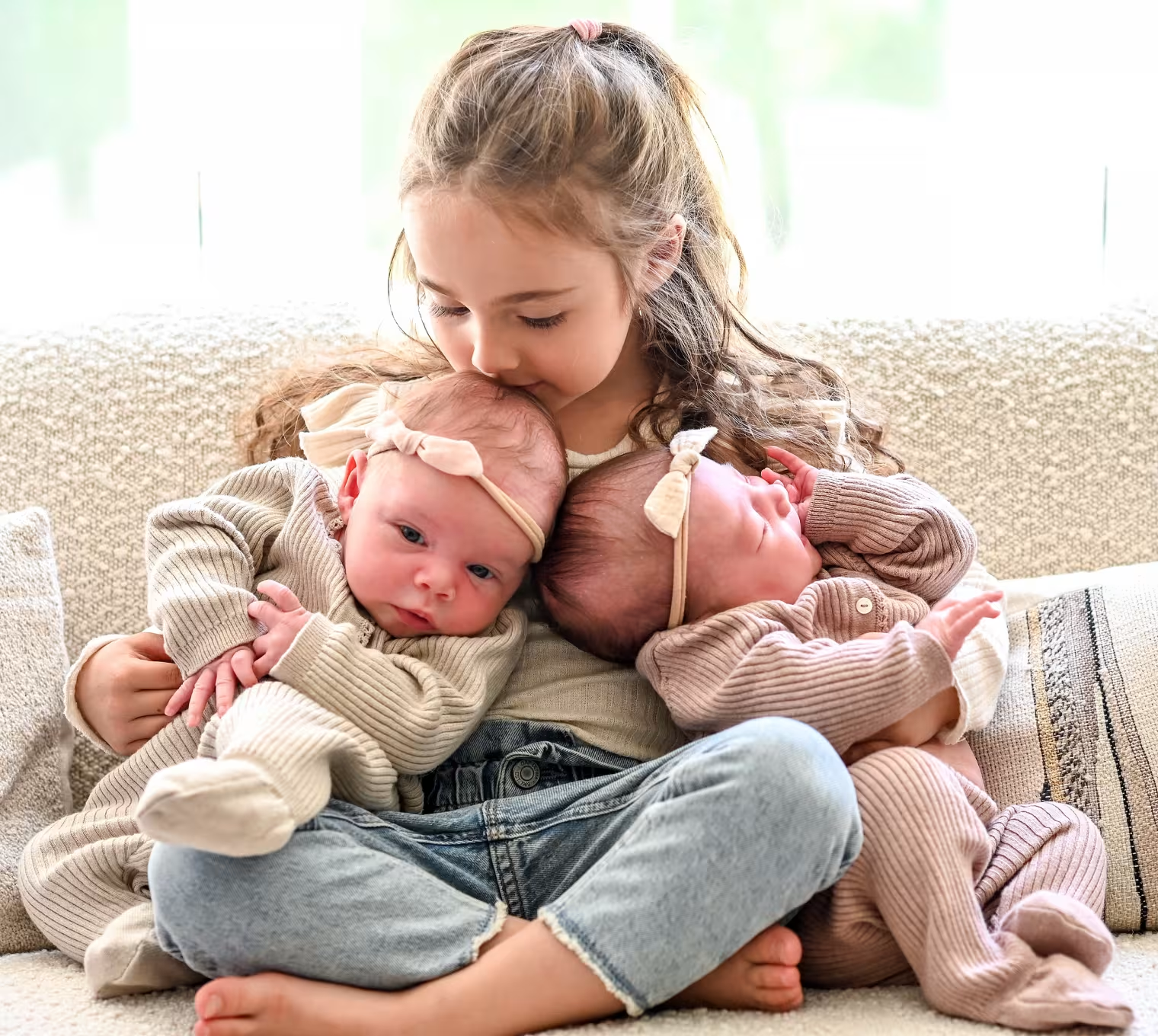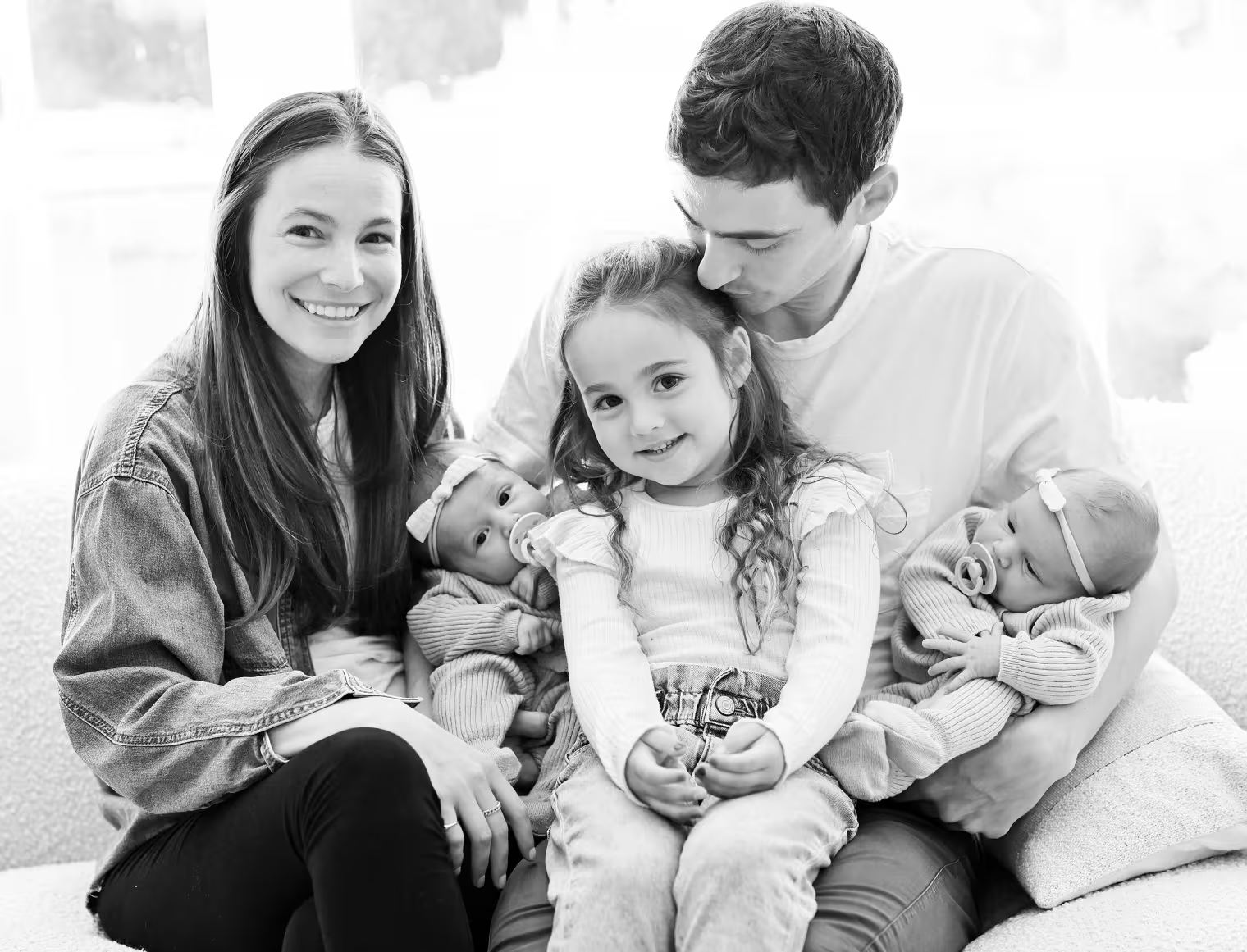
After doctors induced Rachel Storch’s labor in April, it progressed rapidly. Suddenly, she felt sick and struggled to breath. At the time, Michael Storch, had stepped out of the room because he felt queasy. As he rested in the hallway, he heard a code blue being called to his wife’s room.
“That was terrifying,” Michael Storch, 37, of Glencoe, Illinois, tells TODAY.com. “I’m not exaggerating about 60 medical professionals came onto our floor … rushing towards our room.”
Rachel Storch, 36, experienced an amniotic fluid embolism, “a rare but unpredictable and usually catastrophic obstetric emergency,” says Dr. David Ouyang. Suddenly, Michael Storch felt unsure his wife would survive.
“(A staff member) said, ‘You need to call whoever you think needs to be in here in case of the worst,’” he recalls. “I still didn’t understand how serious things were.”
Get Tri-state area news delivered to your inbox.> Sign up for NBC New York's News Headlines newsletter.
A history of uterine scarring
When Rachel Storch gave birth to the couple’s first daughter, Olivia, on January 22, 2020, everything went “smoothly.”
“They did have trouble getting the placenta out,” Rachel Storch says. “All was fine. I ended up going home.”
U.S. & World
Only two days later, though, she experienced “terrible cramps,” that felt like contractions that caused her to writhe in pain on the apartment floor. Later she passed huge blood clots. She visited her doctor, who sent her home by saying that sometimes things like that happened after delivery. As her bleeding increased, she worried.
“I thought something was wrong,” she says. “It was three weeks later to the day that I ended up in the emergency room. I needed back-to-back D&Cs for a retained placenta.”
After the first dilation and curettage (D&C), a procedure that helps doctors remove tissue from the uterus, Rachel Storch started bleeding heavier and doctors needed to perform a second one using ultrasound guidance to slow the hemorrhaging.

“I had a balloon in (my uterus) to stop the bleeding,” she says. “They were measuring how much blood I was losing every 30 minutes to an hour that I was there for the next 24 hours. It was definitely scary.” Once she was stable, she was able to go home and she started recovering. About a year later, though, she experienced more problems and underwent a saline ultrasound where doctors discovered a band of scar tissue encircling her uterus.
A specialist found that scar tissue encased 70% of her uterus and she underwent a surgery to remove it. About a month later and with her doctor’s encouragement, Rachel and Michael Storch tried to get pregnant a second time and they did. But at six weeks, Rachel Storch had a miscarriage.
“We went back to the doctor, she said, ‘All of this scar tissue was back,’ so she removed it again,” Rachel Storch says.
The couple decided to pursue IVF and surrogacy because doctors were unsure if Rachel Storch could get pregnant again. In the meantime, she had to undergo two more procedures to remove excessive scar tissue.
The couple eventually had four viable embryos in September 2022 when they began searching for a surrogate. By March 2023, they matched with one soon after Rachel Storch underwent one final procedure to remove scar tissue from her uterus. In August, they had their first embryo transfer, and it was successful. But just a week prior, the couple received some surprising news.
“I found out I was pregnant,” Rachel Storch says. “We just couldn’t believe it. We didn’t think it was real.”
With her history of miscarriage and scar tissue on her uterus, the couple was anxious about this pregnancy. They later learned from a doctor that he thought there was a “1% chance this (pregnancy) would stick.” But still Rachel Storch’s pregnancy continued normally while her surrogate’s pregnancy also went well. Neither experienced high blood pressure, gestational diabetes or any complications and the babies looked healthy.
“We actually didn’t tell my surrogate until I was 20 weeks because I just couldn’t believe it,” she says.
A rare pregnancy complication
Rachel Storch was due April 27, 2024, and their surrogate was due May 16. Doctors planned to induce both labors. When Rachel Storch arrived on April 22 for her induction, she had no reason to believe anything unusual would occur — even with her past health troubles. Her pregnancy wasn’t even considered high risk.
Yet still, she doesn’t remember anything after she told doctors she was struggling to breathe. Outside of her room, Michael Storch worried about his wife’s life.
“We didn’t really understand what was going on,” he says. “For two hours we were just getting periodic updates. Those were kind of terrifying.”

Later the couple learned that Rachel Storch “had no pulse or heartbeat for 30 seconds,” also known as cardiac arrest, while giving birth.
“The doctor knew immediately what went wrong,” she says. “They immediately started giving me blood.”
Doctors recognized that Rachel Storch experienced an amniotic fluid embolism, which is “like having an allergic reaction,” after amniotic fluid enters the mom’s bloodstream, she says.
“They said it’s completely unpredictable and completely random,” she says. “They also said there’s no treatment, so doctors are basically just responding to your symptoms.”
Ouyang, Rachel Storch's doctor and division director of maternal-fetal medicine at Endeavor Health, where she was treated, was performing a C-section when he saw staff rush to her room. He suspected she was experiencing an amniotic fluid embolism, what’s considered an emergency.
“When amniotic fluid enters the patient’s circulation (it) essentially triggers an overreaction of the immune system, similar to an allergic reaction,” he tells TODAY.com. “The reaction causes two life-threatening events. First the heart and lungs fail, and second, the body’s clotting system goes into disarray, causing severe and persistent bleeding.”
It’s “exceedingly rare,” Ouyang says. “You’re literally more likely to be struck by lightning twice.”
Still, there is no way to identify people at risk of experiencing an amniotic fluid embolism.
“There’s not really objective measures to identify if someone’s going to have it,” he says. “Because we don’t know why it occurs, we can’t do testing (to predict it).”
The staff needed to help Rachel Storch deliver her baby while stabilizing her health. Nurses and residents took turns preforming CPR while the baby was crowing and then doctors used a suction to remove the baby. Then doctors placed Rachel Storch a ventilator and ECMO, a machine that works for the heart and lungs so they can recuperate. But they struggled to control her hemorrhaging.
“She was losing so much blood,” Michael Storch says. “The blood was all being retained in her belly.”
Doctors found 7 liters of blood in her abdomen. They needed to operate on her, but it was risky.
“It was becoming life threatening because it was putting so much pressure on all of her organs,” Michael Storch says. “She wasn’t strong enough … the surgeon basically told me, ‘We’re in between a rock and a hard place. We have to take the blood out of her body. We don’t know if she can (survive).’”
Surgeons found the source of the bleeding, a laceration in her liver, and they stopped that bleeding. Throughout her 18-day stay in the hospital, Rachel Storch received 70 units of blood. Following surgery, Rachel Storch steadily gained strength. Six days after delivery, doctors took her off ECMO and she stayed on the ventilator for an additional day.
As she regained consciousness she experienced “really crazy hallucinations,” and saw people who weren’t there. It wasn’t until she was transferred out of the ICU two days later that she started remembering. Still, her short-term memory remained spotty.
“I didn’t know that I went to the hospital to have a baby,” she says. “I didn’t even know about the baby.”
That baby, Sydney, was healthy and she visited her mom in the ICU.
“When Rachel was a little more stable, we started bringing Sydney,” Michael Storch says. “They were really powerful (visits).”
Sydney rested on Rachel Storch even if she couldn’t hold her or do skin-to-skin thanks to the wires and tubes her mom still needed. Still, the family believes the contact helped steady her blood pressure. On May 9, Rachel Storch moved to a rehabilitation hospital. This too was complicated since Michael Storch had to be with their surrogate who was being induced and later delivered baby, Remi.
“She got put in the NICU (neonatal intensive care unit) for 10 days,” Rachel Storch says. “It was just a lot. Michael was running between me at rehab, our 4-year-old who was at home, and then Remi who was at the NICU in (another) hospital.”
Going home
Doctors thought Rachel Storch would need to be at in-patient rehabilitation for up to three weeks. But she treated it like “boot camp” because she wanted to go home to her family.
“I went to PT and then I was so exhausted I slept in my chair and then I’d go to (occupation therapy) and then rest and then go back to PT,” she says. “It was intense. But it was good.”
After a week on May 16, Rachel Storch returned home while Remi was still in the hospital. Their eldest daughter, Olivia, 4, had a dance recital that Rachel Storch was excited to see. After that, they picked up Remi from the hospital on May 19.
“It’s pretty surreal to be all home together,” she says. “I still have limitations. I’m exhausted. But I’ve recovered pretty quickly. Sometimes it’s hard to remember where we were a few weeks ago.”

The couple treats Sydney and Remi “like twins.”
“They’re just 18 days apart,” Rachel Storch says. “It’s funny at this age we’re able to see the difference a few weeks makes.”
The couple feels grateful that the staff “recognized immediately what happened” and worked to save Rachel Storch’s life.
“Just spreading awareness and helping other doctors and hospitals learn can hopefully save other women’s lives,” she says.
This article first appeared on TODAY.com. More from TODAY:



